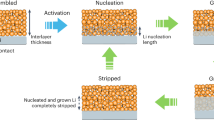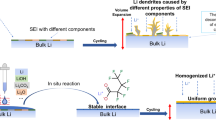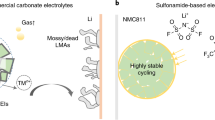Abstract
The long-standing issue of Li-dendrite formation and growth during repeated plating or stripping processes prevents the practical application of Li-metal anodes for high-specific-energy batteries. Here we develop an approach to control dendrite growth by coating the separator with functionalized nanocarbon (FNC) with immobilized Li ions. During cycling, the Li dendrites grow toward each other simultaneously from both the FNC layer on the separator and the Li-metal anode; when the dendrites meet, the growth changes direction: rather than penetrating the separator, a dense Li layer is formed between the separator and the Li anode. This controlled growth alleviates the solid electrolyte interphase formation, reduces the decomposition of the electrolyte, and improves the cyclability of the Li-metal cell. In a Li/LiFePO4 coin cell with three different electrolytes, we show that this approach enables a long stable cycle life (>800 cycles with 80% retention of the initial capacity) and improved efficiency (>97%). Our method offers promise for application in practical Li-metal batteries, and it may also be useful for tackling dendrite issues for other metals.
This is a preview of subscription content, access via your institution
Access options
Access Nature and 54 other Nature Portfolio journals
Get Nature+, our best-value online-access subscription
$29.99 / 30 days
cancel any time
Subscribe to this journal
Receive 12 digital issues and online access to articles
$119.00 per year
only $9.92 per issue
Buy this article
- Purchase on Springer Link
- Instant access to full article PDF
Prices may be subject to local taxes which are calculated during checkout







Similar content being viewed by others
References
Xu, K. Nonaqueous liquid electrolytes for lithium-based rechargeable batteries. Chem. Rev. 104, 4303–4418 (2004).
Tarascon, J. M. & Armand, M. Issues and challenges facing rechargeable lithium batteries. Nature 414, 359–367 (2001).
Armand, M. & Tarascon, J. M. Building better batteries. Nature 451, 652–657 (2008).
Whittingham, M. S. Lithium batteries and cathode materials. Chem. Rev. 104, 4271–4302 (2004).
Selim, R. & Bro, P. Some observations on rechargeable lithium electrodes in a propylene carbonate electrolyte. J. Electrochem. Soc. 121, 1457–1459 (1974).
Epelboin, I., Froment, M., Garreau, M., Thevenin, J. & Warin, D. Behavior of secondary lithium and aluminum-lithium electrodes in propylene carbonate. J. Electrochem. Soc. 127, 2100–2104 (1980).
Rauh, R. D. & Brummer, S. B. The effect of additives on lithium cycling in propylene carbonate. Electrochim. Acta 22, 75–83 (1977).
Aurbach, D., Zinigrad, E., Cohen, Y. & Teller, H. A short review of failure mechanisms of lithium metal and lithiated graphite anodes in liquid electrolyte solutions. Solid State Ion. 148, 405–416 (2002).
Aurbach, D. et al. Attempts to improve the behavior of Li electrodes in rechargeable lithium batteries. J. Electrochem. Soc. 149, A1267–A1277 (2002).
Zheng, G. et al. Interconnected hollow carbon nanospheres for stable lithium metal anodes. Nat. Nanotech. 9, 618–623 (2014).
Shui, J.-L. et al. Reversibility of anodic lithium in rechargeable lithium–oxygen batteries. Nat. Commun. 4, 2255–2261 (2013).
Qian, J. et al. High rate and stable cycling of lithium metal anode. Nat. Commun. 6, 6362–6370 (2015).
Li, W. et al. The synergetic effect of lithium polysulfide and lithium nitrate to prevent lithium dendrite growth. Nat. Commun. 6, 7436–7444 (2015).
Mukherjee, R. et al. Defect-induced plating of lithium metal within porous graphene networks. Nat. Commun. 5, 3710–3719 (2014).
Yang, C.-P., Yin, Y.-X., Zhang, S.-F., Li, N.-W. & Guo, Y.-G. Accommodating lithium into 3D current collectors with a submicron skeleton towards long-life lithium metal anodes. Nat. Commun. 6, 8058–8066 (2015).
Bruce, P. G., Freunberger, S. A., Hardwick, L. J. & Tarascon, J.-M. Li–O2 and Li–S batteries with high energy storage. Nat. Mater. 11, 19–29 (2012).
Monroe, C. & Newman, J. Dendrite growth in lithium/polymer systems: a propagation model for liquid electrolytes under galvanostatic conditions. J. Electrochem. Soc. 150, A1377–A1384 (2003).
Rosso, M., Chassaing, E., Chazalviel, J. N. & Gobron, T. Onset of current-driven concentration instabilities in thin cell electrodeposition with small inter-electrode distance. Electrochim. Acta 47, 1267–1273 (2002).
Ding, F. et al. Dendrite-free lithium deposition via self-healing electrostatic shield mechanism. J. Am. Chem. Soc. 135, 4450–4456 (2013).
Gireaud, L., Grugeon, S., Laruelle, S., Yrieix, B. & Tarascon, J. M. Lithium metal stripping/plating mechanisms studies: a metallurgical approach. Electrochem. Commun. 8, 1639–1649 (2006).
Lu, Y., Tu, Z. & Archer, L. A. Stable lithium electrodeposition in liquid and nanoporous solid electrolytes. Nat. Mater. 13, 961–969 (2014).
Ishikawa, M., Kawasaki, H., Yoshimoto, N. & Morita, M. Pretreatment of Li-metal anode with electrolyte additive for enhancing Li cycleability. J. Power Sources 146, 199–203 (2005).
Ding, F., Liu, Y. & Hu, X. 1,3-dioxolane pretreatment to improve the interfacial characteristics of a lithium anode. Rare Metals 25, 297–302 (2006).
Kanamura, K., Tamura, H., Shiraishi, S. & Takehara, Z.-i. Morphology and chemical compositions of surface films of lithium deposited on a Ni substrate in nonaqueous electrolytes. J. Electroanal. Chem. 394, 49–62 (1995).
Fujieda, T. et al. Surface of lithium electrodes prepared in Ar + CO2 gas. J. Power Sources 52, 197–200 (1994).
Kanamura, K., Okagawa, T. & Takehara, Z.-i. Electrochemical oxidation of propylene carbonate (containing various salts) on aluminium electrodes. J. Power Sources 57, 119–123 (1995).
Choi, N.-S., Lee, Y. M., Park, J. H. & Park, J.-K. Interfacial enhancement between lithium electrode and polymer electrolytes. J. Power Sources 119–121, 610–616 (2003).
Lee, Y. M., Choi, N.-S., Park, J. H. & Park, J.-K. Electrochemical performance of lithium/sulfur batteries with protected Li anodes. J. Power Sources 119–121, 964–972 (2003).
Choi, N.-S., Lee, Y. M., Seol, W., Lee, J. A. & Park, J.-K. Protective coating of lithium metal electrode for interfacial enhancement with gel polymer electrolyte. Solid State Ion. 172, 19–24 (2004).
Zu, C. & Manthiram, A. Stabilized lithium–metal surface in a polysulfide-rich environment of lithium–sulfur batteries. J. Phys. Chem. Lett. 5, 2522–2527 (2014).
Huggins, R. A. Lithium alloy negative electrodes formed from convertible oxides. Solid State Ion. 113–115, 57–67 (1998).
Bang, H. J., Kim, S. & Prakash, J. Electrochemical investigations of lithium-aluminum alloy anode in Li/polymer cells. J. Power Sources 92, 45–49 (2001).
Richardson, T. J. & Chen, G. Solid solution lithium alloy cermet anodes. J. Power Sources 174, 810–812 (2007).
Kim, H. et al. Enhancing performance of Li–S cells using a Li–Al alloy anode coating. Electrochem. Commun. 36, 38–41 (2013).
Zhang, X. et al. Improved cycle stability and high security of Li–B alloy anode for lithium-sulfur battery. J. Mater. Chem. A 2, 11660–11665 (2014).
Cheng, X.-B., Peng, H.-J., Huang, J.-Q., Wei, F. & Zhang, Q. Dendrite-free nanostructured anode: entrapment of lithium in a 3D fibrous matrix for ultra-stable lithium–sulfur batteries. Small 10, 4257–4263 (2014).
Monroe, C. & Newman, J. The impact of elastic deformation on deposition kinetics at lithium/polymer interfaces. J. Electrochem. Soc. 152, A396–A404 (2005).
Panday, A. et al. Effect of molecular weight and salt concentration on conductivity of block copolymer electrolytes. Macromolecules 42, 4632–4637 (2009).
Gomez, E. D. et al. Effect of ion distribution on conductivity of block copolymer electrolytes. Nano Lett. 9, 1212–1216 (2009).
Xu, F. et al. Enhanced Pt/C catalyst stability using p-benzensulfonic acid functionalized carbon blacks as catalyst supports. Electrochim. Acta 94, 172–181 (2013).
Li, Z.-F. et al. Hierarchical polybenzimidazole-grafted graphene hybrids as supports for Pt nanoparticle catalysts with excellent PEMFC performance. Nano Energy 16, 281–292 (2015).
He, H. et al. Failure investigation of LiFePO4 cells in over-discharge conditions. J. Electrochem. Soc. 160, A793–A804 (2013).
Aurbach, D., Gofer, Y. & Langzam, J. The correlation between surface chemistry, surface morphology, and cycling efficiency of lithium electrodes in a few polar aprotic systems. J. Electrochem. Soc. 136, 3198–3205 (1989).
Yamaki, J.-i. et al. A consideration of the morphology of electrochemically deposited lithium in an organic electrolyte. J. Power Sources 74, 219–227 (1998).
Narayanan, S. R., Shen, D. H., Surampudi, S., Attia, A. I. & Halpert, G. Electrochemical impedance spectroscopy of lithium–titanium disulfide rechargeable cells. J. Electrochem. Soc. 140, 1854–1861 (1993).
Zhang, S. S., Xu, K. & Jow, T. R. Electrochemical impedance study on the low temperature of Li-ion batteries. Electrochim. Acta 49, 1057–1061 (2004).
Zhu, Y., Xu, Y., Liu, Y., Luo, C. & Wang, C. Comparison of electrochemical performances of olivine NaFePO4 in sodium-ion batteries and olivine LiFePO4 in lithium-ion batteries. Nanoscale 5, 780–787 (2013).
Chung, S.-Y., Bloking, J. T. & Chiang, Y.-M. Electronically conductive phospho-olivines as lithium storage electrodes. Nat. Mater. 1, 123–128 (2002).
Seong, I. W., Hong, C. H., Kim, B. K. & Yoon, W. Y. The effects of current density and amount of discharge on dendrite formation in the lithium powder anode electrode. J. Power Sources 178, 769–773 (2008).
Yoshimatsu, I., Hirai, T. & Yamaki, J. i. Lithium electrode morphology during cycling in lithium cells. J. Electrochem. Soc. 135, 2422–2427 (1988).
Devaux, D. et al. Failure mode of lithium metal batteries with a block copolymer electrolyte analyzed by X-ray microtomography. J. Electrochem. Soc. 162, A1301–A1309 (2015).
Aurbach, D., Zinigrad, E., Teller, H. & Dan, P. Factors which limit the cycle life of rechargeable lithium (metal) batteries. J. Electrochem. Soc. 147, 1274–1279 (2000).
Slane, S. Measurement of Lithium Cycling Efficiency in Organic Electrolytes (Electronics Technology and Devices Laboratory, 1991).
Roberts, M. et al. Increased cycling efficiency of lithium anodes in dimethyl sulfoxide electrolytes for use in Li–O2 batteries. ECS Electrochem. Lett. 3, A62–A65 (2014).
Kang, S. J. et al. Improved cycle efficiency of lithium metal electrodes in Li–O2 batteries by a two-dimensionally ordered nanoporous separator. J. Mater. Chem. A 2, 9970–9974 (2014).
Chiaramonti, A. N., Thompson, L. J., Egelhoff, W. F., Kabius, B. C. & Petford-Long, A. K. In situ TEM studies of local transport and structure in nanoscale multilayer films. Ultramicroscopy 108, 1529–1535 (2008).
Acknowledgements
The work was partially supported by the Vehicle Technology Office, US Department of Energy (DOE) (Grant No. 1F-32504/DE-AC02-06CH11357), and the National Science Foundation (NSF) (Grant No. 1511645). We would like to acknowledge the Integrated Nanosystems Development Institute (INDI) for the use of their JEOL7800F field-emission scanning electron microscope, which was awarded through NSF grant MRI-1229514. The authors would like to express their appreciation for C. Renguette’s help with English editing. The in situ TEM work was carried out in the Center for Nanoscale Materials at Argonne National Laboratory, an Office of Science user facility supported by the US Department of Energy, Office of Science, Office of Basic Energy Sciences, under Contract No. DE-AC02-06CH11357. Other TEM work was carried out in part at the Center for Functional Nanomaterials at Brookhaven National Laboratory (US DOE contract DE-AC02-98CH10886). Finally, we also thank D. Tien, program director of the Battery Program, Vehicle Technology Office, US DOE, for his support.
Author information
Authors and Affiliations
Contributions
J.X. proposed the concept, designed the experiments, interpreted results, conceived the mechanism, and wrote the manuscript. Yadong L. and Q.L. designed some of the experiments and carried out all the electrochemical work and analysed the electrochemical data with the help of F.Y. L.X. performed all SEM work and L.X. and Yuzi L. carried out the in situ TEM work. E.A.S. helped on manuscript development. All of the authors discussed the results and reviewed the manuscript.
Corresponding author
Ethics declarations
Competing interests
A patent has been filed (patent application number 61/486,946) for controlling the Li dendrite growth via the FNC-coated separator method to make the Li electrode rechargeable.
Supplementary information
Supplementary Information
Supplementary Figures 1–7, Supplementary Table 1, Supplementary Discussion, Supplementary References. (PDF 2016 kb)
Supplementary Video 1
Li-dendrite growth process examined using in situ TEM. A specially designed TEM cell consisting of a Li-metal working electrode, a Li2O solid electrolyte and an FNC layer coated on the surface of Li2O solid electrolyte, was employed to observe the Li dendrite growing process. (MP4 2166 kb)
Rights and permissions
About this article
Cite this article
Liu, Y., Liu, Q., Xin, L. et al. Making Li-metal electrodes rechargeable by controlling the dendrite growth direction. Nat Energy 2, 17083 (2017). https://doi.org/10.1038/nenergy.2017.83
Received:
Accepted:
Published:
DOI: https://doi.org/10.1038/nenergy.2017.83
This article is cited by
-
Lithium-induced graphene layer containing Li3P alloy phase to achieve ultra-stable electrode interface for lithium metal anode
Rare Metals (2024)
-
Transition metals for stabilizing lithium metal anode: advances and perspectives
Tungsten (2024)
-
Two-dimensional materials for high density, safe and robust metal anodes batteries
Nano Convergence (2023)
-
Naked metallic skin for homo-epitaxial deposition in lithium metal batteries
Nature Communications (2023)
-
Gradient design of imprinted anode for stable Zn-ion batteries
Nature Communications (2023)



